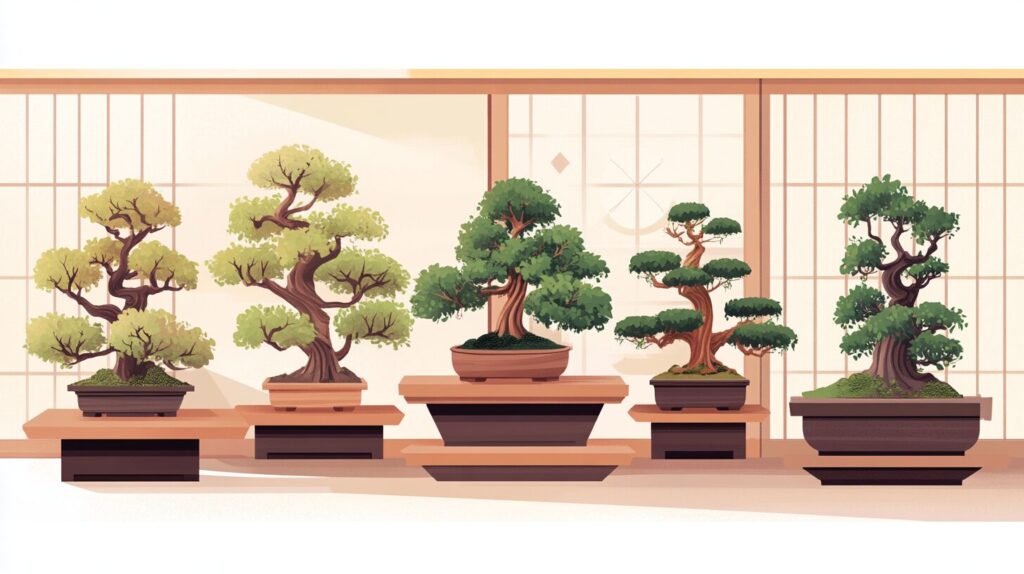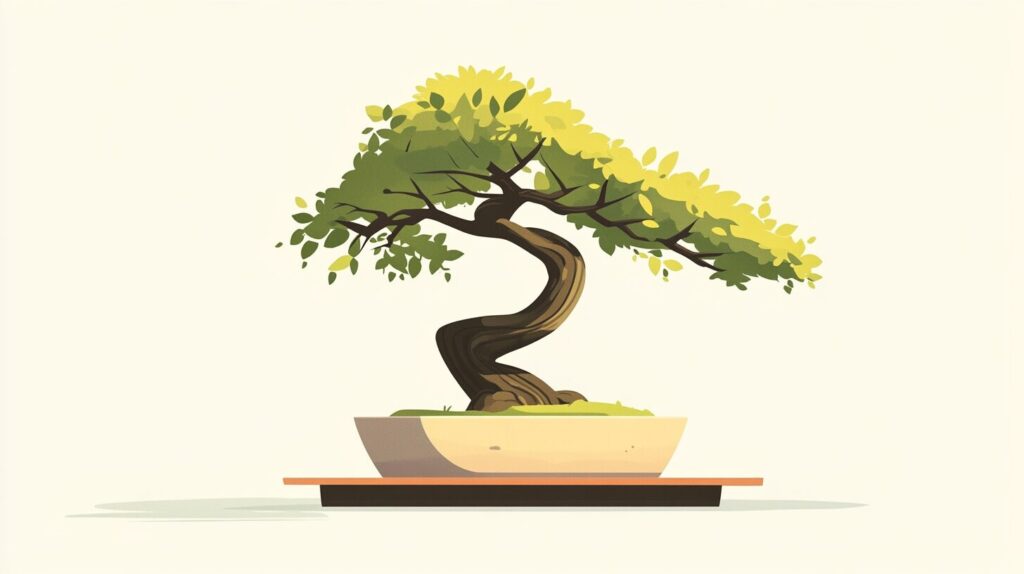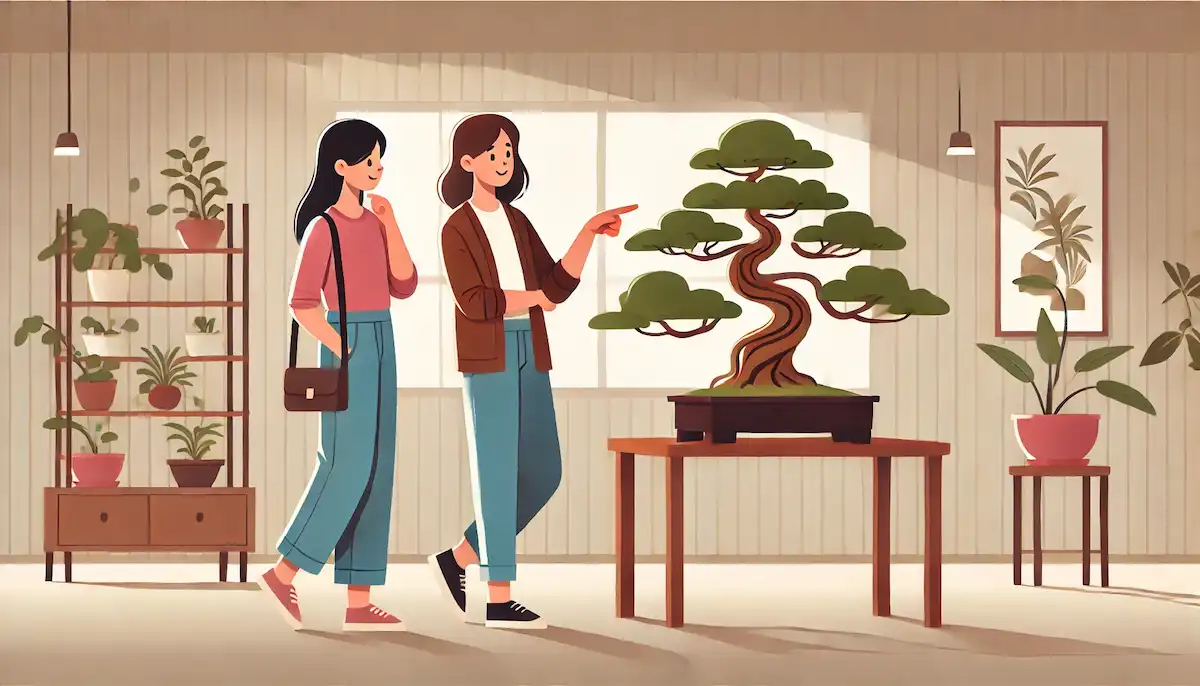盆栽の魅力を英語で説明・紹介するための基本情報と、英会話に役立つ表現をシンプルでわかりやすい英語で紹介します。
英会話ダイアローグ・関連情報・10の質問を通して、盆栽に関する英語表現を学びます。
英語
英会話ダイアローグを読む前に知っておくと良い前提知識と情報です。
- 盆栽とは
- 小さな鉢に木や植物を育て、自然の風景を縮小したように表現するもの
- 盆栽の歴史
- 盆栽の起源は中国の「盆景(ペンジン)」で、平安時代に日本に伝わった
- 日本では、禅の精神や自然との調和を重視して独自の発展を遂げた
- 江戸時代には庶民にも広がり、明治以降は世界的にも評価されるようになった
- 盆栽の特徴
- 自然の再現: 実物の木や風景をミニチュアサイズで表現
- 四季の変化: 春の新芽、夏の緑、秋の紅葉、冬の枝など、一年を通じて異なる美しさを楽しめる
- スタイルの多様性: 直幹(ちょっかん)、斜幹(しゃかん)、懸崖(けんがい)など多彩なスタイルがある
- 盆栽の魅力
- 時間をかけて育てることで、自然とのつながりや達成感を得られる
- 鉢の中で完結するコンパクトな芸術作品として、家の中でも楽しめる
- 忍耐力や集中力を養う趣味としても人気
2人が盆栽について話しています。
盆栽の歴史、特徴、スタイル、季節ごとの変化、寿命、盆栽美術館などを話題にしています。
会話 / dialogue

Hey, Key. I’ve noticed many bonsai trees around recently, and I’m curious about them. Do you know much about bonsai?

Yeah, I do! Bonsai is really fascinating. It’s not just about growing small trees—it’s about creating a miniature version of nature. What got you interested?

They look so peaceful and detailed, almost like little pieces of art. Where does bonsai come from?

Bonsai actually started in China as “penjing,” where people created small landscapes in pots. It came to Japan during the Heian period and became its own unique art here.

So it’s been around for a long time. What makes bonsai so special?

For one, it’s a mix of nature and art. The artist carefully shapes the tree with techniques like pruning and wiring. And bonsai reflects the seasons—it’s amazing to see fresh leaves in spring, vibrant green in summer, red leaves in autumn, and bare branches in winter.

That’s beautiful. Are there different types or styles of bonsai?

Yes! Some common styles include Chokkan, which has a straight trunk, Shakan, where the trunk slants, and Kengai, where the tree cascades downward like a waterfall. Each style has its own feeling and story.

I see. How long do bonsai trees usually live?

They can live for decades or even centuries! Some bonsai trees are over 100 years old and have been passed down through generations. Their trunks and roots show their age and strength.

That’s incredible. Are there any places in Japan where I can see bonsai up close?

Definitely. One of the best places is the Omiya Bonsai Art Museum in Saitama. It has about 120 bonsai trees, including some really famous ones. There’s also the Shunkaen Bonsai Museum in Tokyo, where you can see amazing bonsai and even take lessons.

Wow, I’d love to visit one of those. What’s your favorite thing about bonsai?

I think it’s how bonsai teaches patience. Growing and shaping one takes years, sometimes decades. It’s a slow process that helps you appreciate nature and time.

That sounds rewarding. Do you think it’s hard to start as a beginner?

Not at all. You can start with an easy-to-grow tree like juniper or even a mini bonsai. There are also beginner kits and workshops that make it simple to learn.

That’s good to know. I might give it a try! I’ll start small and see how it goes.

Great idea, Mack. Let me know if you need help, and I’ll join you on your bonsai journey!
関連情報 / related information
「盆栽」について、理解を深めるための「英語での関連情報」です。
盆栽

What is Bonsai?
Bonsai is a traditional Japanese art form of growing and shaping miniature trees in small pots. The goal is to create a natural and beautiful tree that looks like it could exist in nature. Bonsai is not just about growing plants; it is also an art that shows balance, harmony, and creativity.
The History of Bonsai
Bonsai started in China over 1,000 years ago, where it was called “penjing.” It came to Japan during the Heian period (794–1185). Over time, Japan developed its own style, focusing on simplicity and the beauty of nature. Today, bonsai is famous worldwide as part of Japanese culture.
Why is Bonsai Special?
Bonsai trees are special because they are both natural and artistic. They change with the seasons—showing fresh leaves in spring, green growth in summer, colorful leaves in autumn, and bare branches in winter. Bonsai also teaches patience, as shaping a tree takes years of care and attention.
Starting with Bonsai
Beginners can start with easy-to-grow trees like junipers or small bonsai. There are workshops and kits available to learn basic techniques like pruning and wiring. Bonsai is a relaxing hobby that helps you connect with nature and enjoy its beauty in a small, personal way.
10の質問 / 10 questions
「盆栽」について、理解を深めるための「英語での10の質問」です。
1: What is bonsai?
Bonsai is the art of growing and shaping miniature trees in small pots to resemble full-sized trees in nature.
2: Where did bonsai originate?
Bonsai originated in China over a thousand years ago and was later developed in Japan into its own unique art form.
3: What are common styles of bonsai?
Common bonsai styles include formal upright (Chokkan), informal upright (Moyogi), slanting (Shakan), and cascade (Kengai).
4: How long can a bonsai tree live?
With proper care, a bonsai tree can live for many decades, and some can even live for over a hundred years.
5: What materials are needed to start bonsai?
To start bonsai, you need a suitable tree species, a shallow pot, well-draining soil, pruning tools, and wire for shaping.
6: How often should you water a bonsai tree?
The watering frequency depends on the tree species, pot size, and environment, but generally, bonsai trees need to be watered when the soil feels slightly dry to the touch.
7: Can bonsai trees be kept indoors?
Some bonsai species can be kept indoors, but many prefer outdoor conditions. It’s important to choose a species that suits your environment.
8: What is the purpose of pruning in bonsai?
Pruning helps control the size and shape of the bonsai tree, encouraging it to develop the desired form and maintain its miniature appearance.
9: Are there bonsai exhibitions or museums?
Yes, there are bonsai exhibitions and museums, such as the Omiya Bonsai Art Museum in Saitama, Japan, where visitors can learn about and appreciate bonsai art.
10: Is bonsai difficult for beginners?
Bonsai can be challenging, but beginners can start with easy-to-care-for species and gradually learn the techniques. Many resources and communities are available to help newcomers.

和訳付
会話 / dialogue

Hey, Key. I’ve noticed many bonsai trees around recently, and I’m curious about them. Do you know much about bonsai?
やあ、キー。最近あちこちで盆栽を見かけるんだけど、ちょっと興味があるんだ。盆栽のこと、詳しい?

Yeah, I do! Bonsai is really fascinating. It’s not just about growing small trees—it’s about creating a miniature version of nature. What got you interested?
ああ、知ってるよ!盆栽は本当に面白いんだ。単に小さな木を育てるだけじゃなくて、自然をミニチュアで表現することなんだよ。どうして興味を持ったの?

They look so peaceful and detailed, almost like little pieces of art. Where does bonsai come from?
なんていうか、すごく落ち着いていて細部まで美しいし、小さなアートみたいに見えるんだよね。盆栽ってどこから来たの?

Bonsai actually started in China as “penjing,” where people created small landscapes in pots. It came to Japan during the Heian period and became its own unique art here.
実は、盆栽は中国で「盆景」という名前で始まったんだ。鉢の中に小さな風景を作るものだった。それが平安時代に日本に伝わって、独自の芸術に発展したんだよ。

So it’s been around for a long time. What makes bonsai so special?
じゃあ、すごく昔からあるんだね。盆栽が特別なのはどんなところ?

For one, it’s a mix of nature and art. The artist carefully shapes the tree with techniques like pruning and wiring. And bonsai reflects the seasons—it’s amazing to see fresh leaves in spring, vibrant green in summer, red leaves in autumn, and bare branches in winter.
まず、自然と芸術が融合しているところかな。剪定や針金かけといった技術で、木を丁寧に形作っていくんだ。そして、盆栽は四季を反映するんだよ。春の新芽、夏の緑、秋の紅葉、冬の枝の美しさなんて、本当に素晴らしいよ。

That’s beautiful. Are there different types or styles of bonsai?
それは素晴らしいね。盆栽にはいろんな種類やスタイルがあるの?

Yes! Some common styles include Chokkan, which has a straight trunk, Shakan, where the trunk slants, and Kengai, where the tree cascades downward like a waterfall. Each style has its own feeling and story.
あるよ!たとえば、「直幹」は幹がまっすぐ伸びた形、「斜幹」は幹が斜めになっている形、「懸崖」は木が滝みたいに下に垂れ下がるスタイルだよ。それぞれに独自の雰囲気や物語があるんだ。

I see. How long do bonsai trees usually live?
なるほど。盆栽の木って、普通どれくらい生きるの?

They can live for decades or even centuries! Some bonsai trees are over 100 years old and have been passed down through generations. Their trunks and roots show their age and strength.
何十年も、場合によっては何世紀も生きることがあるよ!100年以上の盆栽もあって、世代を超えて受け継がれているんだ。幹や根を見ると、その年輪や力強さを感じられるよ。

That’s incredible. Are there any places in Japan where I can see bonsai up close?
それはすごいね。日本で盆栽を間近で見られる場所ってある?

Definitely. One of the best places is the Omiya Bonsai Art Museum in Saitama. It has about 120 bonsai trees, including some really famous ones. There’s also the Shunkaen Bonsai Museum in Tokyo, where you can see amazing bonsai and even take lessons.
もちろん。埼玉の「大宮盆栽美術館」はおすすめだよ。そこには約120点の盆栽があって、有名なものも多いんだ。それから、東京の「春花園BONSAI美術館」もいいよ。素晴らしい盆栽が見られるし、レッスンも受けられるんだ。

Wow, I’d love to visit one of those. What’s your favorite thing about bonsai?
わあ、どっちかに行ってみたいな。キーは盆栽のどんなところが好き?

I think it’s how bonsai teaches patience. Growing and shaping one takes years, sometimes decades. It’s a slow process that helps you appreciate nature and time.
やっぱり、盆栽が忍耐を教えてくれるところかな。育てたり形を作ったりするのに何年、時には何十年もかかるんだ。そのゆっくりしたプロセスが、自然や時間をもっと大切に思わせてくれるんだよ。

That sounds rewarding. Do you think it’s hard to start as a beginner?
それはやりがいがありそうだね。初心者が始めるのは難しいと思う?

Not at all. You can start with an easy-to-grow tree like juniper or even a mini bonsai. There are also beginner kits and workshops that make it simple to learn.
全然そんなことないよ。たとえば、育てやすい木のジュニパーや、ミニ盆栽から始められるしね。初心者向けのキットやワークショップもあって、学びやすいよ。

That’s good to know. I might give it a try! I’ll start small and see how it goes.それはいいことを聞いたよ。やってみようかな!まずは小さいのから始めて、どうなるか試してみるよ。

Great idea, Mack. Let me know if you need help, and I’ll join you on your bonsai journey!
それはいい考えだよ、マック。何か手伝いが必要なら教えてね。一緒に盆栽の世界を楽しもう!
関連情報 / related information
盆栽

What is Bonsai?
Bonsai is a traditional Japanese art form of growing and shaping miniature trees in small pots. The goal is to create a natural and beautiful tree that looks like it could exist in nature. Bonsai is not just about growing plants; it is also an art that shows balance, harmony, and creativity.
盆栽は、小さな鉢の中で木を育てて形を作る、日本の伝統的な芸術です。目指すのは、自然界にあるような美しく自然な木を再現することです。盆栽は単に植物を育てるだけでなく、バランスや調和、創造性を表現する芸術でもあります。
The History of Bonsai
Bonsai started in China over 1,000 years ago, where it was called “penjing.” It came to Japan during the Heian period (794–1185). Over time, Japan developed its own style, focusing on simplicity and the beauty of nature. Today, bonsai is famous worldwide as part of Japanese culture.
盆栽は約1,000年前に中国で始まり、「盆景」と呼ばれていました。それが平安時代(794〜1185年)に日本に伝わりました。日本ではシンプルさや自然美を重視した独自のスタイルが発展しました。現在では、盆栽は日本文化の一部として世界中で有名です。
Why is Bonsai Special?
Bonsai trees are special because they are both natural and artistic. They change with the seasons—showing fresh leaves in spring, green growth in summer, colorful leaves in autumn, and bare branches in winter. Bonsai also teaches patience, as shaping a tree takes years of care and attention.
盆栽の木は、自然と芸術が融合しているため特別です。春の新芽、夏の緑、秋の紅葉、冬の枝の姿など、季節ごとに異なる美しさを見せてくれます。また、木の形を整えるには何年もかかるため、盆栽は忍耐力を教えてくれるものでもあります。
Starting with Bonsai
Beginners can start with easy-to-grow trees like junipers or small bonsai. There are workshops and kits available to learn basic techniques like pruning and wiring. Bonsai is a relaxing hobby that helps you connect with nature and enjoy its beauty in a small, personal way.
初心者は、ジュニパーや小さな盆栽など育てやすい木から始めるとよいでしょう。剪定や針金かけといった基本的な技術を学べるワークショップやキットもあります。盆栽はリラックスできる趣味で、自然とつながり、小さな空間でその美しさを楽しむことができます。
10の質問 / 10 questions
1: What is bonsai?
盆栽とは何ですか?
Bonsai is the art of growing and shaping miniature trees in small pots to resemble full-sized trees in nature.
盆栽は、小さな鉢の中で木を育てて形を作り、自然の大木のように見せる芸術です。
2: Where did bonsai originate?
盆栽はどこで生まれましたか?
Bonsai originated in China over a thousand years ago and was later developed in Japan into its own unique art form.
盆栽は1000年以上前に中国で生まれ、その後日本で独自の芸術として発展しました。
3: What are common styles of bonsai?
盆栽の一般的なスタイルは何ですか?
Common bonsai styles include formal upright (Chokkan), informal upright (Moyogi), slanting (Shakan), and cascade (Kengai).
一般的な盆栽のスタイルには、直幹、模様木、斜幹、懸崖があります。
4: How long can a bonsai tree live?
盆栽の木はどれくらいの期間生きられますか?
With proper care, a bonsai tree can live for many decades, and some can even live for over a hundred years.
適切に管理すれば、盆栽の木は何十年も生きることができ、100年以上生きるものもあります。
5: What materials are needed to start bonsai?
盆栽を始めるのに必要な材料は何ですか?
To start bonsai, you need a suitable tree species, a shallow pot, well-draining soil, pruning tools, and wire for shaping.
盆栽を始めるには、適した樹種、浅い鉢、水はけの良い土、剪定用の道具、形を整えるための針金が必要です。
6: How often should you water a bonsai tree?
盆栽の木にはどのくらいの頻度で水をあげるべきですか?
The watering frequency depends on the tree species, pot size, and environment, but generally, bonsai trees need to be watered when the soil feels slightly dry to the touch.
水やりの頻度は樹種、鉢の大きさ、環境によりますが、一般的には土が少し乾いていると感じたときに水をあげます。
7: Can bonsai trees be kept indoors?
盆栽の木は室内で育てられますか?
Some bonsai species can be kept indoors, but many prefer outdoor conditions. It’s important to choose a species that suits your environment.
室内で育てられる盆栽もありますが、多くの盆栽は屋外を好みます。環境に適した樹種を選ぶことが大切です。
8: What is the purpose of pruning in bonsai?
盆栽で剪定を行う目的は何ですか?
Pruning helps control the size and shape of the bonsai tree, encouraging it to develop the desired form and maintain its miniature appearance.
剪定は盆栽の木の大きさや形を調整し、希望の形に育てたり、その小さな姿を保つために行われます。
9: Are there bonsai exhibitions or museums?
盆栽の展示会や美術館はありますか?
Yes, there are bonsai exhibitions and museums, such as the Omiya Bonsai Art Museum in Saitama, Japan, where visitors can learn about and appreciate bonsai art.
はい、盆栽の展示会や美術館があります。例えば、埼玉の大宮盆栽美術館では、盆栽の芸術を学び楽しむことができます。
10: Is bonsai difficult for beginners?
盆栽は初心者にとって難しいですか?
Bonsai can be challenging, but beginners can start with easy-to-care-for species and gradually learn the techniques. Many resources and communities are available to help newcomers.
盆栽は難しいと感じることもありますが、初心者は育てやすい樹種から始め、徐々に技術を学ぶことができます。初心者をサポートする資料やコミュニティもたくさんあります。

words & phrases
英会話ダイアローグと関連情報に出てきた単語・フレーズです(例文は各3つ)。

pruning : 名詞
意味: 不要な枝を切り取ること。The act of cutting off branches or parts of a plant to improve its growth or shape.
(盆栽の形を整えたり、小型サイズを維持するための重要な技術を指す)
例文:
- Pruning is essential for maintaining the shape of a bonsai tree.
「剪定は盆栽の形を保つために欠かせません。」 - The gardener spent the afternoon pruning the roses.
「庭師は午後いっぱいを使ってバラの剪定をしました。」 - Proper pruning helps the tree grow stronger and healthier.
「適切な剪定は木をより強く健康に育てるのに役立ちます。」
vibrant : 形容詞
意味: 鮮やかで活気があること。Full of energy, color, or life.
(盆栽の木が四季ごとに見せる、特に夏や秋の鮮やかな葉の色を表現するのに使われる)
例文:
- The vibrant autumn leaves of the bonsai are breathtaking.
「盆栽の鮮やかな秋の葉は息をのむほど美しいです。」 - She wore a vibrant red dress to the party.
「彼女はパーティーに鮮やかな赤いドレスを着ていきました。」 - The city’s vibrant nightlife attracts many tourists.
「その街の活気ある夜の生活は多くの観光客を引きつけます。」
trunk : 名詞
意味: 木の幹または胴体部分。The main stem of a tree or the central part of something.
(盆栽の幹を指し、その形状がスタイル形成の重要な要素であると説明される。)
例文:
- The trunk of the bonsai was carefully shaped over years.
「盆栽の幹は長い年月をかけて慎重に形作られました。」 - The elephant used its trunk to grab the fruit.
「ゾウはその鼻で果物をつかみました。」 - He packed his clothes in the car trunk.
「彼は服を車のトランクに詰めました。」
cascade : 名詞・動詞
意味: 小さな滝、または連続的に流れるもの。A small waterfall or something that flows or falls in stages.
(盆栽のスタイル「懸崖(けんがい)」を説明する際、幹が滝のように下に流れる形を表すのに使用)
例文:
- The cascade style of bonsai mimics a tree growing on a cliff.
「盆栽の懸崖スタイルは崖で育つ木を模倣しています。」 - The river formed a beautiful cascade in the forest.
「その川は森の中で美しい滝を形成していました。」 - Her hair cascaded down her back.
「彼女の髪は背中に滝のように流れていました。」
rewarding : 形容詞
意味: やりがいがあり、満足感が得られること。Providing satisfaction or a sense of achievement.
(盆栽の育成が時間を要するが、達成感を得られる趣味であると説明する際に使用)
例文:
- Growing and shaping bonsai is a rewarding experience.
「盆栽を育て形を作ることはやりがいのある経験です。」 - Teaching children can be challenging but very rewarding.
「子どもたちを教えることは難しいですが、とてもやりがいがあります。」 - Volunteering at the shelter was a rewarding way to spend my weekend.
「シェルターでのボランティア活動は、充実した週末の過ごし方でした。」
